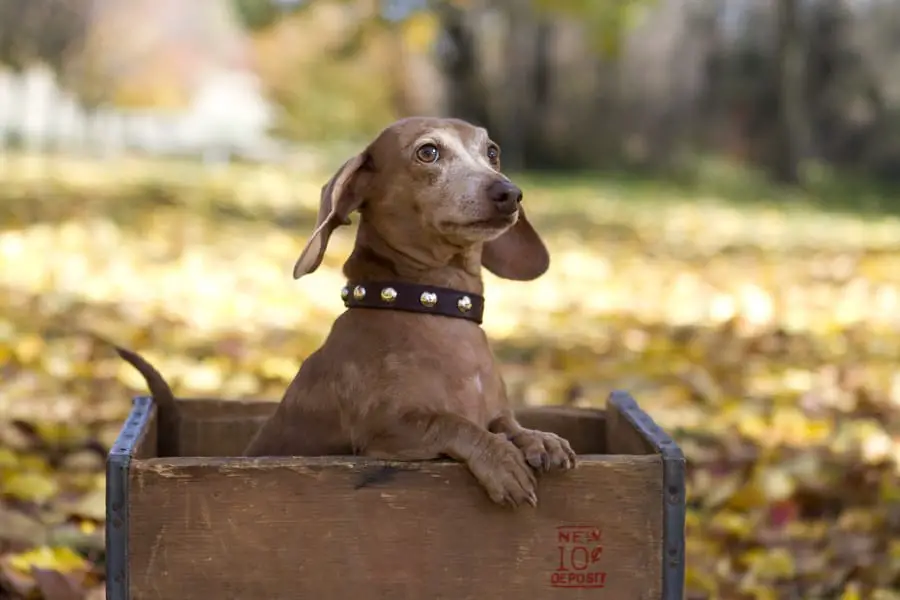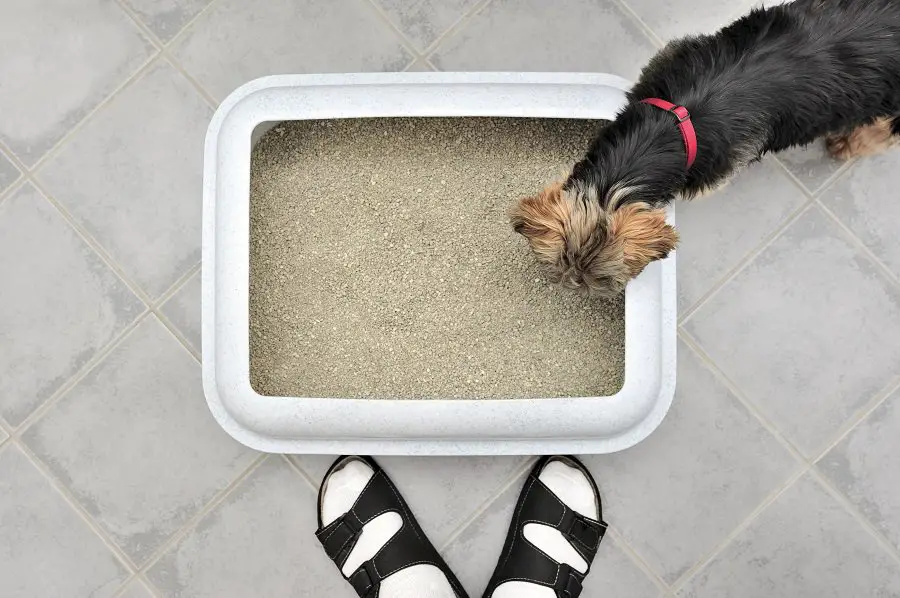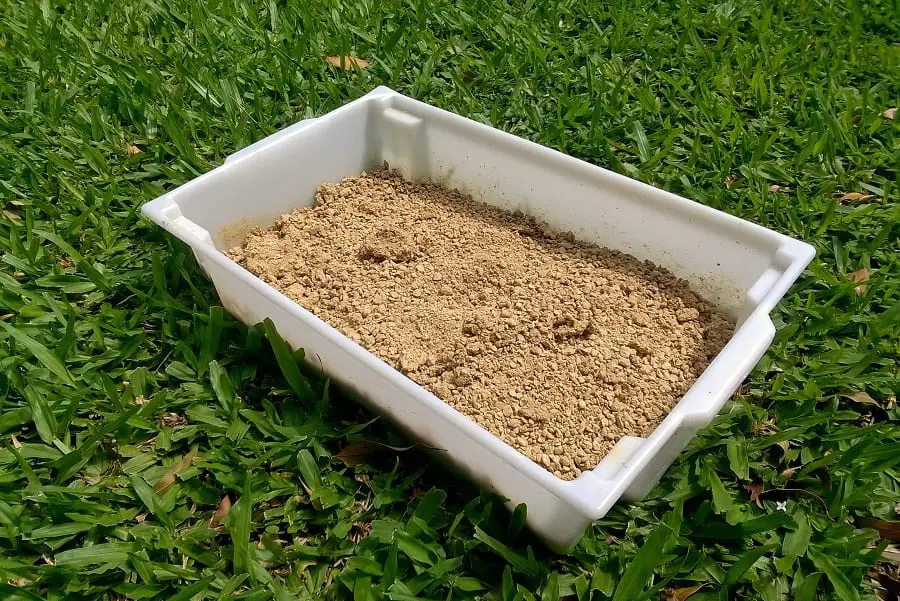Talk about ‘litter box for a pet’ and most of us are conditioned to immediately think about cats.
Not many dog owners would relate litter boxes with their pets, and even more would dismiss it outright as a crazy idea. But is it really that crazy?
Can dogs, normally used to relieving themselves outside the home, be trained to use a litter box indoors? And why would one want to go through this hassle in the first place?
There are very good reasons why training your dog to use a litter box inside a home can be useful.
This is particularly true for smaller dogs like dachshunds, as they have smaller bladders and need to relieve themselves more frequently than larger dogs.

A dachshund has two advantages that also make the use of a litter box practical – the first is its size, which doesn’t require you to keep a large box in your house; the second is its intelligence, which makes it relatively easy to train it, if done in the right manner.
Let us quickly cover the main benefits of litter box training, followed by some important steps to remember when familiarizing and training your dachshund with a litter box, and finally understanding the kind of litter box that works for a dog (hint: it’s not the usual cat litter box).
Benefits of Litter Box Training
It is important to understand first that use of a litter box cannot completely replace the need to take your dog out every day.
But if you stay in an apartment, with no easy access to an open yard, it can help if your dog can take care of some of its business indoors instead of having to wait for you to take out in time.
This additional option for the dog can not only save you extra cleaning work in case of indoor accidents, but, and more importantly, can prevent bladder infection in the dog caused by ‘holding it’ for too long.
This training also comes in handy if you are away from home for long periods.
If there’s a litter box inside the house, you are less likely to be welcomed by a funky-smelling mess when you get back home tired.
Similarly, if your dog feels the urge to go while you are enjoying your sleep at night, it won’t have to wake you up.
So, litter box training can make life easy for both you and your pet. The training itself is really not that much of a hassle either.
Litter Box Training
Unlike with cats, who take quite naturally to litter boxes, dogs do require some effort with formal training.
But the process is not very different from the outdoor potty training you would go through anyway with your dog.
As mentioned earlier, this is slightly easier with dachshunds because they learn fast, provided the trainer is consistent, firm and patient.
Never scold or punish your dachshund if it takes time to pick up the process or has a few accidents during the learning period.
Negative behavior can scare or confuse a dog, especially one as sensitive as a dachshund. Positive reinforcement and rewards for getting things right help a lot.
Also, the ideal time to begin litter box training is when the dog is a pup. Changing habits as it grows older can be difficult, but older dogs can be trained too using the same steps.
Here are the main steps we suggest for this training process:
Familiarize Your Dachshund with The Litter Box
Before anything else, your dog needs to get comfortable with entering and spending time in the new box. Keep a newspaper or pad in the box to begin with.
Place the dog in the box and use a phrase like “go potty” so that it learns to relate the command with the box.

If your dog leaves the box, pick it up and place it inside again, and repeat the phrase. Show the dog that you are happy that it has gone into the box.
Gradually, your dog will get comfortable with being inside this new thing. Then try to direct the dog with just the phrase and without touching it.
Use the phrase once and be patient. If it has still not picked up the command, try guiding physically and gently again.
Praise the dog generously as the dog learns to enter the box on hearing your command.
Help the Dog Understand the Purpose of The Litter Box
A dog does not naturally associate a box with a place to relieve itself.
To help it realize that it is acceptable to eliminate in this part of the house, soak a newspaper in the dog’s urine and place inside the box.
You can also pick some of the dog’s feces from outside and put it inside.
As the dog gets used to the litter box, gradually begin replacing the newspaper with litter.
Look for Signs that Your Dog Needs to Relieve Itself
Typical signs include whining, pacing near the door and sniffing around the house.
When you note any of these signs, immediately take the dog to the litter box and use the command it is being trained with.
Most dogs, but particularly younger ones, will feel the need to eliminate 5 to 30 minutes after their meal.
Maintain a Schedule
While dogs need to relieve themselves at irregular intervals throughout the day, there are certain points when they are more likely to do so.
Train them to use the litter box just before going to bed at night, after waking up in the morning and before they are being left alone for a long period.
Young pups need to pee more often, about once every hour. But as they reach about 4-5 months of age, they can hold their pee through the night.
For the dog to have regular toilet behavior, it is also important that it has a regular feeding schedule. Avoid any feeding between meals.
Keep the Litter Box Easily Accessible
A dachshund likes to stay around the central part of the house from where it can keep an eye on all goings on.
Place the litter box close to where the dog spends most of its waking time, ideally where it can see the box.
Since the dog tends to move towards the door anytime it feels the need to relieve itself, placing the box near the door also helps in reinforcing the association.
If you are leaving the dog alone, keep the box in the room where the dog is most likely to spend its time.
Do not move the box around too much to avoid confusing the dog. Keep the box easily accessible, but private.
Dogs do not like someone watching them when they are relieving themselves.
Reward Your Dog
Use incentives like treats, praise or play to reward your dachshund when it uses the litter box to pee or poop during the training period.
Always accompany your dog to the litter box during this period.
Once your dog begins using the litter box on its own, do not cut off the rewards abruptly. Gradually decrease the dog’s dependence on treats, but continue to praise it.
Clean The Litter Box Regularly
Your dog will not use the litter box if it gets too dirty. Scoop out and throw the poop every time your dog uses the litter box.

Keeping a litter scoop and step-on trash can close by makes this easy. Empty the box out and clean it well with water and soap once every 2-3 weeks.
Stay Calm in Case of Accidents
There will be minor mishaps in every training process. If the dog pees or poops outside the litter box, do not scold it. Never rub its nose in the mess.
Saying a firm “No” and directing the dog to the box is enough to help it learn.
If the dog has just begun relieving itself, a few sharp claps can make him stop. Run along with it to the box, encourage it to use the box and praise it for following the command.
Making a Litter Box
Source
While litter boxes of different sizes for dogs are available in the market, you can also build one on your own easily.
You just need a simple plastic tub or a travel crate (with the top and front removed) for this.
If you are buying a litter box, you can check out more advanced versions that include a self-cleaning function, a cover or a layer of grass on top with waste collection underneath.
Dimensions
The size of the box depends on the size of your dog.
Dog litter boxes need to be a few inches deep and should have enough space for your dog to move and turn around in and pick the right spot.

As the pup grows into an adult dog, the size of the box should be increased.
Walking into the box should be easy. Male dogs lift their leg to pee, so the walls of the box should be high enough to keep the spray from falling outside.
Filler
Do not use cat litter for your dog’s litter box. It can cause health issues if your dog ingests the litter. Dog litter has larger, more absorbent pellets.
Materials used to make dog litter are biodegradable and can include clay and activated charcoal.
The latter helps in controlling the odor, but it is also strongly advised to sprinkle baking soda before filling the box with litter for odor control.
Avoid changing the litter type once your dog gets used to a particular variety.
Placement
We have already discussed keeping the litter box at an easily accessible, but private, area inside the house.
Do not place the box close to the area where your dog has its meals.
Dogs tend to dig in their box before and/or after relieving themselves, so do not place the box where litter is thrown out, during digging, as this could cause a mess.
You can try fencing in the litter area with plastic sheets to keep dirt from spreading in the room.
Placing the box on a tiled floor is ideal for cleaning, but if you have carpeted flooring in your home, spread some newspaper under the litter box.
Number
It is perfectly fine to have more than one litter box for one dog.
You could keep one where the dog spends its day (say, the living room), while the other could be kept in the bedroom where the dog sleeps at night.
Of course, the litter used should be the same in each of these boxes.
Keep a separate litter box for each of your dogs to prevent any fights between them. Never make your cat and your dog share a litter box.
Dogs and especially cats use urine to mark their territory and being made to share the main area where they release their urine can result in unnecessary aggressive behavior.
So, there, you have it. Making a litter box and training your dachshund to use it can take some time and patience early on, but it is a very useful practice in the long run.
Apart from all the other benefits, it saves your dear pet from avoidable discomfort.
And as your dog grows old, this training can also save it the physical stress involved in making frequent trips to relieve itself.
